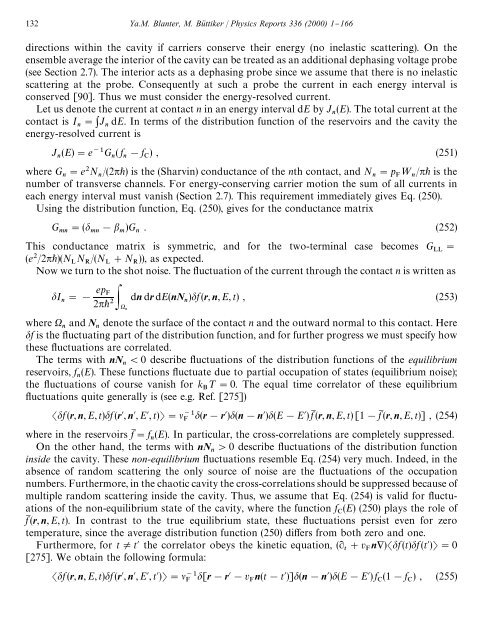shot noise in mesoscopic conductors - Low Temperature Laboratory
shot noise in mesoscopic conductors - Low Temperature Laboratory
shot noise in mesoscopic conductors - Low Temperature Laboratory
You also want an ePaper? Increase the reach of your titles
YUMPU automatically turns print PDFs into web optimized ePapers that Google loves.
132 Ya.M. Blanter, M. Bu( ttiker / Physics Reports 336 (2000) 1}166<br />
directions with<strong>in</strong> the cavity if carriers conserve their energy (no <strong>in</strong>elastic scatter<strong>in</strong>g). On the<br />
ensemble average the <strong>in</strong>terior of the cavity can be treated as an additional dephas<strong>in</strong>g voltage probe<br />
(see Section 2.7). The <strong>in</strong>terior acts as a dephas<strong>in</strong>g probe s<strong>in</strong>ce we assume that there is no <strong>in</strong>elastic<br />
scatter<strong>in</strong>g at the probe. Consequently at such a probe the current <strong>in</strong> each energy <strong>in</strong>terval is<br />
conserved [90]. Thus we must consider the energy-resolved current.<br />
Let us denote the current at contact n <strong>in</strong> an energy <strong>in</strong>terval dE by J (E). The total current at the<br />
contact is I "J dE. In terms of the distribution function of the reservoirs and the cavity the<br />
energy-resolved current is<br />
J (E)"eG ( f !f ) , (251)<br />
where G "eN /(2) is the (Sharv<strong>in</strong>) conductance of the nth contact, and N "p = / is the<br />
number of transverse channels. For energy-conserv<strong>in</strong>g carrier motion the sum of all currents <strong>in</strong><br />
each energy <strong>in</strong>terval must vanish (Section 2.7). This requirement immediately gives Eq. (250).<br />
Us<strong>in</strong>g the distribution function, Eq. (250), gives for the conductance matrix<br />
G "( ! )G . (252)<br />
This conductance matrix is symmetric, and for the two-term<strong>in</strong>al case becomes G "<br />
(e/2)(N N /(N #N )), as expected.<br />
Now we turn to the <strong>shot</strong> <strong>noise</strong>. The #uctuation of the current through the contact n is written as<br />
I "!<br />
ep dn dr dE(nN )f (r, n, E, t) , (253)<br />
2 <br />
<br />
where and N denote the surface of the contact n and the outward normal to this contact. Here<br />
<br />
f is the #uctuat<strong>in</strong>g part of the distribution function, and for further progress we must specify how<br />
these #uctuations are correlated.<br />
The terms with nN (0 describe #uctuations of the distribution functions of the equilibrium<br />
<br />
reservoirs, f (E). These functions #uctuate due to partial occupation of states (equilibrium <strong>noise</strong>);<br />
<br />
the #uctuations of course vanish for k ¹"0. The equal time correlator of these equilibrium<br />
<br />
#uctuations quite generally is (see e.g. Ref. [275])<br />
f (r, n, E, t)f (r, n, E, t)"(r!r)(n!n)(E!E)<br />
fM (r, n, E, t)[1!fM (r, n, E, t)] , (254)<br />
<br />
where <strong>in</strong> the reservoirs fM "f (E). In particular, the cross-correlations are completely suppressed.<br />
<br />
On the other hand, the terms with nN '0 describe #uctuations of the distribution function<br />
<br />
<strong>in</strong>side the cavity. These non-equilibrium #uctuations resemble Eq. (254) very much. Indeed, <strong>in</strong> the<br />
absence of random scatter<strong>in</strong>g the only source of <strong>noise</strong> are the #uctuations of the occupation<br />
numbers. Furthermore, <strong>in</strong> the chaotic cavity the cross-correlations should be suppressed because of<br />
multiple random scatter<strong>in</strong>g <strong>in</strong>side the cavity. Thus, we assume that Eq. (254) is valid for #uctuations<br />
of the non-equilibrium state of the cavity, where the function f (E) (250) plays the role of<br />
<br />
fM (r, n, E, t). In contrast to the true equilibrium state, these #uctuations persist even for zero<br />
temperature, s<strong>in</strong>ce the average distribution function (250) di!ers from both zero and one.<br />
Furthermore, for tOt the correlator obeys the k<strong>in</strong>etic equation, (R #v n)f (t)f (t)"0<br />
<br />
[275]. We obta<strong>in</strong> the follow<strong>in</strong>g formula:<br />
f (r, n, E, t)f (r, n, E, t)"<br />
[r!r!v n(t!t)](n!n)(E!E) f (1!f ) , (255)
















